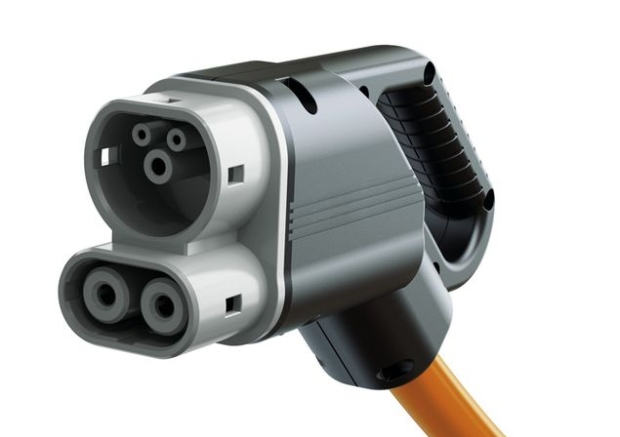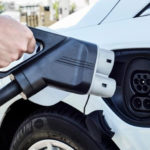Part 1 introduced some of the issues related to charging of electric vehicles. Part 2 continues with a look at the hardware (which also involves software, of course).
Q: What about the electrical and physical connections?
A: There are three connection situations, called “cases”:
- Case A has the charger connected to the AC mains, and is usually associated with modes 1 or 2; the mains supply cable is usually attached to the charger itself
- Case B has an onboard vehicle charger and a mains supply cable which can be detached from both the supply and the vehicle—usually mode 3.
- Case C is for a dedicated charging station with DC supply to the vehicle. The mains supply cable may be permanently attached to the charge-station such as in mode 4.
Q: What about the physical plugs?
A: There are four plug types:
- Type 1 – single-phase vehicle coupler, defined by the SAE J1772/2009 automotive plug specifications
- Type 2 – single- and three-phase vehicle coupler, meeting the VDE-AR-E 2623-2-2 plug specifications
- Type 3 – single- and three-phase vehicle coupler equipped with safety shutters, reflecting the EV Plug Alliance proposal
- Type 4 – fast charge coupler, for special systems such as CHAdeMO
Q: What is the most-common charger and connector?
A: Level 1 and Level 2 are the most commonly encountered charger/connector pairings. Level 1 uses the car’s built-in charger (electric vehicle onboard charger – EVOBC) and can be plugged with one end into any standard 120 VAC outlet, with the other end being plugged directly into the car. Level 2 chargers are external and are sold separately from the car and are connected to a 240 VAC outlet for charging three to seven times faster depending on the electric car and the charger. Level 1 and Level 2 chargers have an SAE J1772 connector (Figure 1).

The CCS (Combined Charging Standard) is an increasingly widely used variation that defines a single connector pattern on the vehicle side with enough space for a Type 1 or Type 2 connector, along with space for a two-pin DC connector allowing charging at up to 200 Amps (Figure 2).

Q: Is the charger like an adapter/wall charger used for laptops and other devices, only with higher capacity?
A: No, it is very far from it. The basic charger must do more than transform the voltage/current and deliver it to the battery pack in the vehicle. It must “talk” to the pack to ascertain the state of the various cells, including their charge, state of health, capacity, and more It must meter the charge so as not to overcharge or overheat the batteries, and engage in a “conversation” with the battery pack and its in-vehicle management subsystem,.
Due to the amount of current and thus power being transferred, the charger must have multiple levels of fault monitoring. It must detect everything from a basic high-resistance bad connection to a short circuit, and many possible problems that that may occur. The charging operation involves both high voltages – lethal in themselves, regardless of current – plus large amounts of current – meaning large amounts of power in a confined volume and area.
Q: Is EV charging a “localized” function?
A: In some cases, it is, but it cannot remain so. Since EV charging draws so much current, having many active charging stations in a small locale might overwhelm the ability of the grid to supply the current. Smart charges talk to the grid, to balance their individual demands versus the other users. The smart charger can shift its loading to where the grid is less heavily loaded — of course; this may delay the charging uptake.
A smart charger must shift battery charging loads to run when there is less power demand on the grid. This requires the EV to send the vehicle’s battery state-of-charge to the utility. Without it, vehicle owners face the risk of not charging the battery properly. Over a larger area, the networked EV charging systems are part of intelligent charging solutions where chargers are linked with the grid and charging system operators.
Q: What’s so special about Tesla charging?
A: Tesla supercharging stations can deliver up to nearly 150 kW of power to two adjacent cars at the station (and limited to a maximum of 120 kW per vehicle). It’s a fast-charging system, for sure: about 20 minutes to charge to 50%, 40 minutes to 80%, and 75 minutes to 100% for the lower-capacity Tesla model battery packs. But these charging stations and their requisite grid feed lines are not widely available. Also keep in mind that larger battery packs give more range, but do not improve the miles/minute metric.
Q: Wireless charging is a “hot” topic for smartphones, earbuds, and laptops; is there an equivalent for EVs?
A: Yes, such designs are being tested. In principle, it’s a very convenient solution: just drive your car over the charging pad, the inside-car console tells you when you are properly positioned, and charging begins. The technology is based on inductive charging, which involves electricity being transferred via an air gap between two magnetic coils (Figure 3).

Q: What’s the status of wireless charging?
A: WiTricity Corp. licenses wireless charging technology to automakers and suppliers. Last year, BMW began offering wireless charging using WiTricity’s system, Hyundai introduced a version of its Kona outfitted for wireless charging at last year’s Geneva Auto Show, and it’s being tested on a fleet in Chengdu, China. Another provider is the Evatran Group with a Plugless Power system. WiTricitry claims power transfer nearly as efficient and as fast as a conventional plug-in, at 90-93% from grid to battery and lull Level 2 charging (3.6 – 11 kW+). They also say their system it can be used on a road surface or with in-ground placement and will work through asphalt, cement, snow, ice. The pad measures 4 feet wide by about 3 feet front-to-back.
Q: What are some likely benefits of wireless charging?
A: It’s user friendly, no need to get out of the car and connect the system; also, it may be done more locally, at parking spots, taxi-stand waiting lines, and similar, so it allows more frequent “fill-ups” and this perhaps smaller battery packs (less cost and weight), Finally, it’s more aligned with operation of autonomous vehicles, since the car can drive itself to the charging set-up and initiate the process without manual intervention of connecting the charger.
Q: And the possible drawbacks?
A: The relatively high efficiency (90 to 93%) of the wireless system is still less than that of a directly connect system which has little interconnect-transfer loss, and this differential slows recharging and also adds to the load on the grid. There’s an issue of building and installing the pads and infrastructure so that it may make the most sense in residential and commercial garages; finally, some people have health concerns about the low-intensity magnetic field.
Q: What does typical charging circuitry look like?
A: In a word, it’s complicated. The block diagram of a basic Level 1 and Level 2 Electric Vehicle Service Equipment (EVSE) Reference Design only hints at the design reality, (Figure 4). There are also link protocols and formats which do not show up on that diagram.

This introductory discussion of the “ins and outs’ of charging EVs is related to, but separate from, their battery issues, range, optimizing battery life, managing EV power use, and more. The contrast with the refueling of IC vehicles is certainly dramatic. Perhaps within a decade, the EV situation will be simple “plug and play” as well; that remains to be seen, of course. However, a large part of the difference is defined by the underlying physics of their differences in energy density and delivery, and that will not be changing.
References
- OP Conference Series: Materials Science and Engineering, “Comparison of Different Battery Types for Electric Vehicles”
- Wikipedia, “Charging Station”
- Wikipedia, “Type 2 connector”
- Wikipedia, “Combined Charging System”
- Electrify America, “About Electric Vehicle (EV) Charging”
- Wikipedia, “SAE J1772”
- S. Department of Energy, “Vehicle Charging”
- ChargeHub, “2019 Guide On How To Charge Your Electric Car With Charging Stations”
- EVConnectors LTD, “Type 2 Electric Vehicle Charging Cables and Sockets”
- FleetCarma, “How soon is wireless electric vehicle charging coming?”
- Forbes, “Wireless Electric Vehicle Charging Puts An End To Range ‘Arms Race’”
- Powerstream, “How to calculate battery run-time”
- Plug-In Cars, “SAE Unveils Combined Charger System”
- Charged Electric Vehicle Magazine, “Scaling EV charging infrastructure: Standards and interoperability”
- CleanTechnica, “CCS Becoming Dominant DC Charging Standard In Europe — Will Nissan Drop CHAdeMO?”
- Zap Map/Next Green Car Ltd, “Guide to EV charging”
- Pod Point, “EV Charging Connector Types and Speeds”
- EMotorWerks, “The Different EV Charging Connector Types”
- Edmunds, “Electric Car Battery Basics: Capacity, Charging and Range”
- Texas Instruments, TIDUB87, “TI Designs Level1 and Level2 Electric Vehicle Service Equipment (EVSE) Reference Design”
- Texas Instruments, “Level 1&2 Electric Vehicle Service Equipment Reference Design”
- Texas Instruments, “AC charging (pile) station”
- Texas Instruments, TIDA-01604, “6% Efficiency, 6.6-kW Totem-Pole PFC Reference Design for HEV/EV Onboard Charger”
- Texas Instruments, TIDM-02002, “Bidirectional CLLLC resonant dual active bridge (DAB) reference design for HEV/EV onboard charger”





The claims of 90% to 93% efficiency for wireless charging seem very suspect, given that the claimed efficiency of wireless charging of cell phones is given as 60% to 65%. And there is the issue of that 10% that is lost being quite a bit. Consider that 10% of 100 kilowatt hours is TEN kilowatt hours that go someplace else. That is a whole lot of power un-accounted for, in either heat or radiated interference. Just like other forms of pollution, lost energy goes someplace, it does not just disappear. It may be that the radiated lost power is the show-stopper for wireless charging.